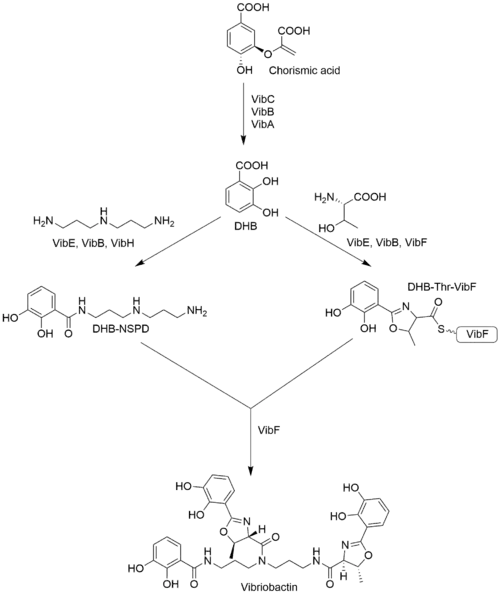 | |
| Names | |
|---|---|
| Systematic IUPAC name
(4S,5R)-N-[3-(2,3-Dihydroxybenzamido)propyl]-2-(2,3-dihydroxyphenyl)-5-methyl-N-{3-[(4R,5S)-5-methyl-2-(2,3-dihydroxyphenyl)-4,5-dihydro-1,3-oxazole-4-carboxamido]propyl}-4,5-dihydro-1,3-oxazole-4-carboxamide | |
| Identifiers | |
3D model (JSmol) |
|
| ChEBI |
|
| ChemSpider | |
| KEGG | |
PubChem CID |
|
| |
| |
| Properties | |
| C35H39N5O11 | |
| Molar mass | 705.721 g·mol−1 |
Except where otherwise noted, data are given for materials in their standard state (at 25 °C [77 °F], 100 kPa).
Infobox references | |
Vibriobactin is a catechol siderophore that helps the microbial system to acquire iron. It was first isolated from Vibrio cholerae.[1]
Structure and biosynthesis
The components of vibriobactin are three 2,3-dihydroxybenzoic acid (DHB), two threonine (Thr), and one norspermidine (NSPD). DHB is synthesized from chorismic acid by a series of enzymes: VibA, VibB, and VibC. DHB is linked to NSPD by VibE, VibB and VibH in order and forms DHB-NSPD.[2] On the other hand, DHB performs condensation and cyclization with Thr by VibE, VibB, and VibF to form the heterocyclic molecule linked on VibF: DHB-Thr-VibF. DHB-NSPD and DHB-Thr-VibF are then put together by VibF to form vibriobactin.[3]

References
- ↑ Griffiths, Gary L.; Sigel, Suzanne P.; Payne, Shelley M.; Neilands, J. B. (1984). "Vibriobactin, a Siderophore from Vibrio cholerae". The Journal of Biological Chemistry. 259 (1): 383–385. doi:10.1016/S0021-9258(17)43671-4. PMID 6706943.
- ↑ Keating, Thomas A.; Marshall, C. Gary; Walsh, Christopher T. (2000). "Vibriobactin Biosynthesis in Vibrio cholerae: VibH Is an Amide Synthase Homologous to Nonribosomal Peptide Synthetase Condensation Domains". Biochemistry. 39 (50): 15514. doi:10.1021/bi001651a. PMID 11112537.
- ↑ Marshall, C. Gary; Burkart, Michael D.; Keating, Thomas A.; Walsh, Christopher T. (2001). "Heterocycle Formation in Vibriobactin Biosynthesis: Alternative Substrate Utilization and Identification of a Condensed Intermediate". Biochemistry. 40 (35): 10656. doi:10.1021/bi010937s. PMID 11524010.
This article is issued from Wikipedia. The text is licensed under Creative Commons - Attribution - Sharealike. Additional terms may apply for the media files.